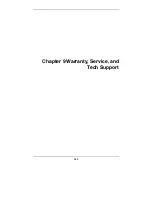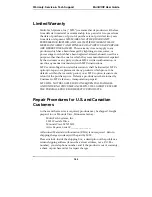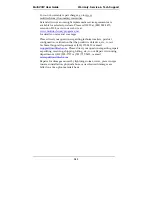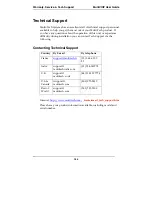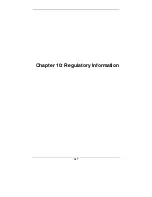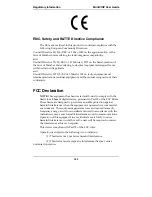
MultiVOIP User Guide
Cable Pinouts
357
ISDN Interfaces: “ST” and “U”
The MVP410ST and MVP810ST are ISDN-BRI voip units that use an
S/T outlet interface. You will need an NT1 device to connect these units
to any network equipment that has the “U” ISDN interface. In the UK,
and in many European countries, the telco supplies an NT1 device for
ISDN-BRI service.
An ISDN Basic Rate (BRI) U-Loop consists of two conductors from the
telco central office to the customer premises. The equipment on both
sides of the U-loop accommodates the extensive length of the U-loop
and the noisy environment in which it may operate. At the customer
premises, the U-loop is terminated by an NT1 (network termination 1 )
device. An NT1 device makes an end-user’s 4-wire terminal equipment
compatible with the telco’s 2-wire twisted pair ISDN-BRI line.
The NT1 drives an S/T bus. The S/T bus is usually made up of 4 wires,
but in some cases may be 6 or 8 wires.
“S” and “T” refer to connection points in the ISDN specification.
When a PBX is present,
S
refers to the connection between the PBX and
the terminal. (“Terminal” can mean any sort of end-user ISDN device:
data terminals, telephones, FAX machines, voip units, etc.)
Point
T
refers to the connection between the NT1 device and customer
supplied equipment. Terminals can connect directly to the NT1 device
at point
T
, or there may be a PBX (private branch exchange, i.e., a
customer-owned telephone exchange). The figure below shows “S” and
“T” connection points in an ISDN network.
Telco
Central
Office
Point “S”
Point “T”
4-8 Wires
Point “S”
4-8 Wires
Point “U”
2 Wires
Point “S”
NT1
NT2
(PBX)
Terminal
Terminal
Terminal
Summary of Contents for MULTIVOIP MVP-3010
Page 6: ...6 Chapter 1 Overview ...
Page 28: ...28 Chapter 2 Quick Start Instructions ...
Page 38: ...Technical Configuration T1 E1 MultiVOIP User Guide 38 Chapter 4 Software Installation ...
Page 49: ...49 Chapter 5 Technical Configuration ...
Page 58: ...Technical Configuration MultiVOIP User Guide 58 Config Info CheckList ...
Page 117: ...MultiVOIP User Guide Technical Configuration 117 ...
Page 139: ...MultiVOIP User Guide Technical Configuration 139 ...
Page 170: ...170 Chapter 6 T1 Phonebook Configuration North American Telephony Standards ...
Page 184: ...T1 Phonebook Configuration MultiVOIP User Guide 184 3 Select Inbound PhoneBook List Entries ...
Page 208: ...208 Chapter 7 E1 Phonebook Configuration European Telephony Standards ...
Page 252: ...252 Chapter 8 Operation and Maintenance ...
Page 257: ...MultiVOIP User Guide Operation Maintenance 257 The Call Progress Details Screen ...
Page 265: ...MultiVOIP User Guide Operation Maintenance 265 The Logs Screen ...
Page 277: ...MultiVOIP User Guide Operation Maintenance 277 ...
Page 280: ...Operation and Maintenance MultiVOIP User Guide 280 T1 Statistics Screen ...
Page 288: ...Operation and Maintenance MultiVOIP User Guide 288 ...
Page 343: ...343 Chapter 9 Warranty Service and Tech Support ...
Page 347: ...347 Chapter 10 Regulatory Information ...
Page 352: ...352 Appendix A Cable Pinouts ...
Page 358: ...358 Appendix B TCP UDP Port Assignments ...
Page 360: ...360 Appendix C Installation Instructions for MVP428 Upgrade Card ...
Page 365: ...MultiVOIP User Guide Index 365 Index ...
Page 395: ...395 S000384A ...

